The beautiful region of Normandy lies just across the Channel, making it a great choice for a school trip that avoids having to spend too long sat on a coach.
And yet, it’s still relatively free from the tourist hordes (who tend to rush through the region and on to Paris).
In our opinion, Normandy is still a real hidden gem. Plus, there are educational activities here for any number of subjects, including French, history and food technology, making it a great choice for cross-curricular tours.
Here are our experts’ top picks for activities to include on your trip to Normandy.
- Pegasus Memorial
- 360° Cinema – Arromanches
- Arromanches Landings Museum
- German Battery at Longue-sur-Mer
- Normandy American Cemetery Visitor Centre
- Bayeux Tapestry
- Fromagerie Graindorge
Pegasus Memorial
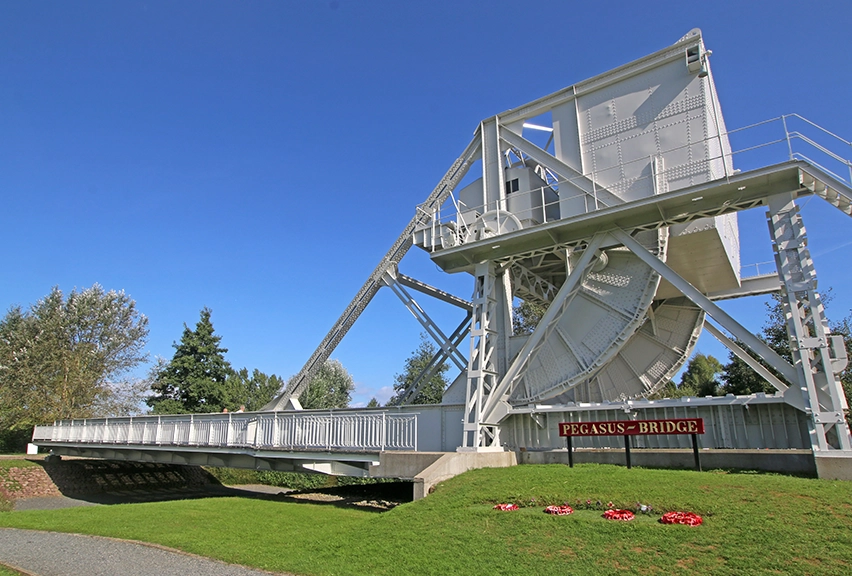
The Pegasus Memorial is dedicated to the men of the 6th Airborne Division and their role during the Battle of Normandy. They were the first to land on French soil on the night of the 5th to 6th June 1944.
You’ll enjoy a guided tour of the museum, which can be provided in English or French and typically lasts around an hour and a half.
When our team visited the memorial, they were met by their guide Mark and given a tour of the exhibition hall, where they were shown lots of original historical objects and photos.
They then visited the bridge (originally known as Bénouville Bridge and now known as Pegasus Bridge) which was the first objective taken by Allied troops in the Battle of Normandy. The bridge you see nowadays is the original bridge (although it has been repainted to help preserve it), and you can still see the bullet holes and other marks made during the fighting. Our team felt it was a really impressive sight, and were really impressed by the sheer quantity of exhibits in the museum.
360° Cinema – Arromanches
A real highlight of any history trip to Normandy is a visit to the 360° Cinema in Arromanches. This is a circular cinema dedicated to bringing the story of the D-Day landings to life using archive footage (from British, French, Canadian, German and American archives) and state-of-the-art animation. It also serves as an emotional tribute to the 20,000 civilians killed during one of the most ambitious military actions of the 20th century.
The film shown here lasts about 20 minutes and is called “The 100 Days of the Battle of Normandy”.
A full visit usually lasts about 45 minutes (you’ll need to arrive 15 minutes before your reservation) and the film is shown on the hour and at half past the hour. There’s no dialogue in the film (so no worries about a language barrier) and your coach will be able to park at the cinema (otherwise it’s a bit of a hike up a steep set of stairs from Arromanches itself).
Pro-tip: You can actually book 360° Cinema – Arromanches with a visit to the Memorial de Caen, which is one of the best WW2 museums in France.
It does have a focus on the Battle of Caen, in particular, but does cover much of WW2, the 20th Century (even touching on the Cold War) and the fragility of peace.
There’s a great exhibition on D-Day and the Normandy Landings, as well as a reconstruction of General Richter’s underground bunker, and an exhibition showing students what life was really like in France under Nazi occupation. Guided tours are available in English or French, and you should expect this visit to last about 75 minutes.
Arromanches Landings Museum
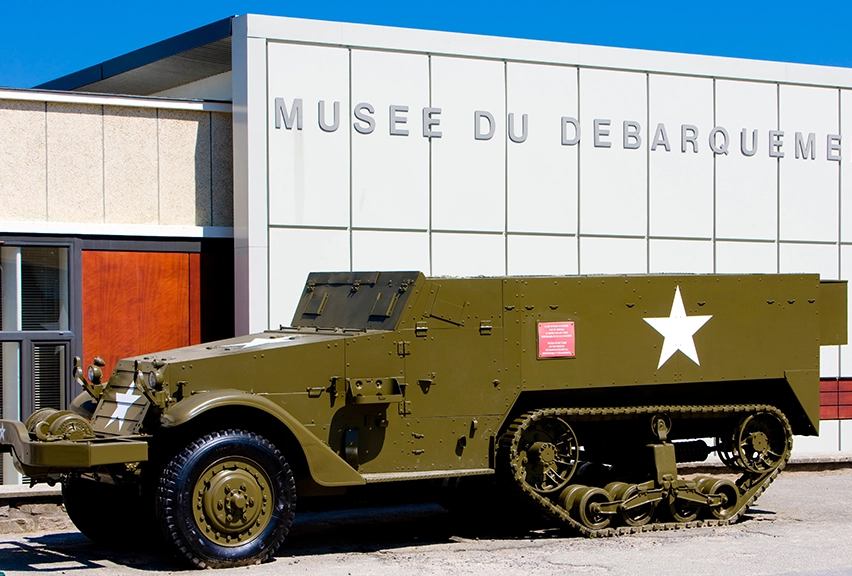
Troops avoided landing at Arromanches itself, to keep it clear for the Mulberry harbour that was brought here from southern England. The Mulberry harbours were a temporary port that allowed cargo to be quickly offloaded on to the beaches during the Allied invasion of Normandy in June 1944.
The Arromanches Landings Museum was the first museum dedicated to the D-Day landings and the Battle of Normandy. It was built on the harbour of Arromanches, overlooking Gold Beach (one of the landing beaches).
The museum consists of four sections. The first is a gallery of working models to illustrate how the Mulberry harbours worked.
Then there’s a diorama, that’s been designed to bring the events of the early hours of D-Day to life.
There’s a section which looks at the Allied nations that took part in the landings (here, your students will see uniforms and medals from the Allied forces).
You’ll usually have a guided tour of these sections, to help make sure your students understand the historic significance of everything they’re seeing.
You’ll also have the chance to see two separate films about the invasion and the subsequent building of the Mulberry harbours (a temporary solution used by the Allies to supply their armies in Europe before they could capture a port in France).
This is a visit that really does bring to life the huge effort involved, as well as the ingenuity and innovation required to construct these temporary ports to allow supplies to be fed in to support the invasion.
Arromanches’ Mulberry harbour became known as Port Winston (after Sir Winston Churchill) and was in service for five months. Over the course of those five months, 2.5 million men, 4 million tonnes of supplies and 500,000 vehicles arrived in France via Port Winston.
You’ll usually need about an hour and a half for this visit.
German Battery at Longues-sur-Mer
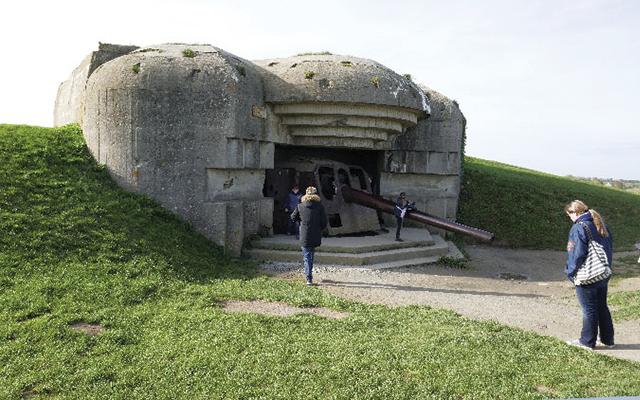
The German Battery at Longues-sur-Mer takes you to the other side of the battle lines and gives you an idea of the power of the ‘Atlantic Wall’ that the invading forces were up against.
This particular site contains four 152mm naval guns. They may seem incredibly out of place in the quiet French countryside, but they serve to show how much World War Two disrupted life all over the continent, even in seemingly sleepy northern French villages.
The battery itself is just a short 5-minute stroll from the car park and tourist information office (which has a shop and toilets available). You won’t need too long for this visit (and certainly no more than an hour). Guided tours in English and French are available.
Alternatively (or, in addition), you could visit the Merville Battery. Each bunker here houses an exhibition with a different theme. One even simulates the attack by British Paratroopers on the German position, so it feels like you’re in the middle of the battle.
The pièce de résistance is undoubtedly the authentic American C-47 plane used in the operation.
Normandy American Cemetery Visitor Centre
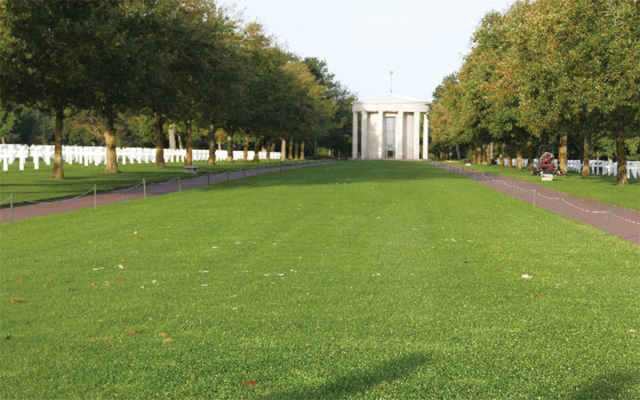
The Normandy American Cemetery Visitor Centre is very informative and provides an interesting take on the D-Day landings (from the American perspective) through films and exhibits.
The cemetery is the final resting place of nearly 9,400 American servicemen and women, and there are another 1,600 names on the memorial in the Garden of the Missing.
There is a lovely chapel here with a beautiful ceiling mosaic depicting America blessing her sons as they leave for France to fight for freedom. And there are two granite statues in the west end of the cemetery representing America and France.
If you’re lucky, you may get to witness the raising of the flags above the cemetery with Omaha Beach in the background (which is a really sobering experience and something that will really resonate with your students).
Bayeux Tapestry
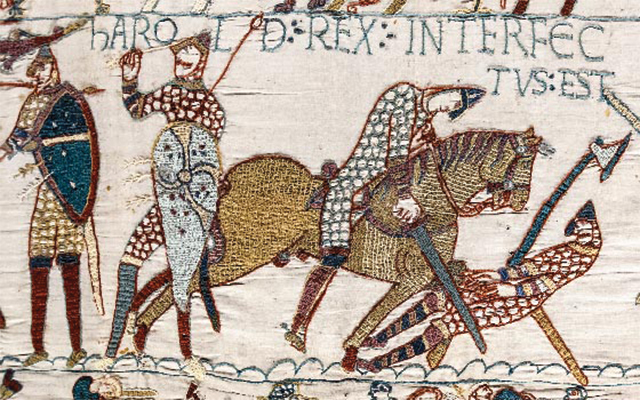
The Bayeux Tapestry Museum is home to the famous 70m long tapestry that tells the story of how William the Conqueror became King of England in 1066.
Now, we should mention here that the museum is actually closed for renovation until October 2027, so if you are travelling before that you won’t be able to visit.
If you are keen for students to see the tapestry, you’ll be interested to learn that it’s being loaned to the British Museum between Autumn 2026 and July 2027 (so, they can see it in London for free). This will be the first time it’s shown in England since it was made nearly 1,000 years ago.
But, back to the Bayeux Tapestry Museum in Normandy. The museum is made up of three floors. On the ground floor, you’ll find the tapestry itself, which you’ll explore with the help of an audio guide.
The first floor looks at how the tapestry was made, as well as the historic context in which it was made. And on the second floor you can watch a 16-minute film explaining the story the tapestry tells and who the main characters featured are.
Fromagerie Graindorge
You can’t go to Normandy without visiting one of the incredible producers. This region is famous for its dairy cattle and apple orchards (and this is reflected in the area’s gastronomy). Butter, cream and cheese rule the roost here, and many dishes are hearty and rich.
One of our favourite visits is to the Fromagerie Graindorge. Specialising in the production of the four Norman Protected Designations of Origin (PDO) cheeses (Livarot, Pont l’Eveque, Camembert de Normandie and Neufchatel).
The fromagerie was established in Livarot in 1910 and continues to be run by the same family.
You’ll need to visit in the morning (because that’s when the cheese is produced), when you’ll enjoy a free self-guided visit that includes the opportunity to taste some of the cheese (now you see why we love this visit).
You’ll follow the different stages of cheese production (from the moment the milk arrives at the fromagerie to the moment it’s ready to leave for the shops) as you walk along a gallery of glass-protected galleries.
The visit is in French, but English subtitles are provided, and it typically lasts about 90 minutes. There is also an option to add on workshops (for a fee).
If you’re not that into cheese, there are a few other foodie visits you could consider instead.
Got a sweet tooth? Normandy is also the birthplace of brioche and is well known for its confectionery too, especially for Isigny caramels. You can visit Caramels d’Isigny, where you’ll find out how these caramels are made with demonstrations of the various stages. You’ll also get to taste the caramels (and you’ll all be given a bag to take away, too).
Prefer biscuits? Head to Les Sablés d’Asnelles, an artisanal biscuit factory. Or if you have a group of chocoholics, you could head to Chocolaterie du Drakkar to discover the history of chocolate and its production.
Unusually for France, very little wine is produced here. Cider and calvados are the local tipples in here, so you could opt for a visit to an orchard, cider works and calvados distillery instead.
Bonus tips
Hopefully, we’ve given you a better idea of some of the exciting opportunities waiting for you in Normandy. It’s a real treat for groups focusing on medieval or WW2 history, food technology or French language. But it’s also a great choice for cross-curricular trips because of the choice of activities there.
The journey times are pretty reasonable too, and France’s modern motorway network will see you reach Le Havre in just 2.5 hours from Calais.
As well as all the history and foodie activities here, you’ll probably want to spend a bit of your time exploring some of Normandy’s most famous sights. Mont St Michel, for example, is iconic and well worth a visit. It’s a UNESCO World Heritage Site and it’s free to visit the mount (so, it’d be rude not to).
Another famous sight is the charming town of Honfleur. Many groups choose to stop here on the way to or from Calais. You can spend some time exploring the historic port and the lovely old town.
If you’re taking a group of French students and are wondering how to make sure they really engage with the French language and make the most of their time in Normandy, you might want to add our activity trail ‘Battle of the Bistros’.
As group leader, you’ll take on the role of Suzy Sucre to lead a virtual gameshow around the town of Bayeux. Your students will play in teams, completing activities in specific locations around the town to see who’ll come out on top. Your pack (with activity booklets for the students, risk assessment and organiser’s notes) will be posted to you before you travel.
Ready to start planning your school trip to Normandy?
Just get in touch if you’d like more information on any of the activities here, or if you want any more information about school trips to Normandy. Or, if you’re ready to dive in, ask us for a no-obligation, tailor-made quote today.